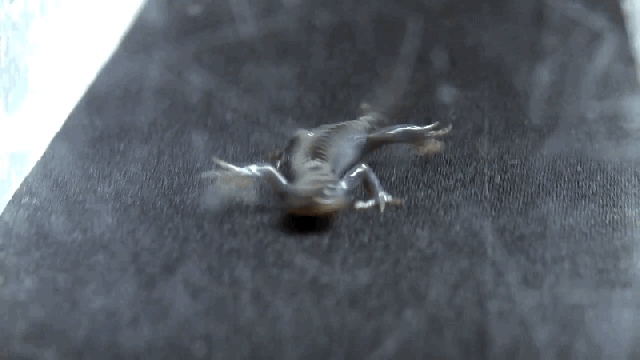Animals will go to great lengths to find a mate, but there’s a species of salamander that’s willing to traverse extreme distances over treacherous terrain to find that special amphibian someone.
A new study published in Functional Ecology shows that mole salamanders travel an average of six miles (10 km) — and in some cases as far as nine miles (15 km) — to new breeding sites. At first blush that might not sound so extreme, but when you consider the salamander’s tiny stature and stubby legs, not to mention all those crazy things that can wrong along the way, it’s an impressive feat by any measure.
Heading into the study, the researchers quickly realised that they couldn’t really follow salamanders along their lengthy journey, nor could they place geo-tracking monitors on the animals’ delicate skin. So, the research team from Ohio State University cross-referenced genetic details from salamanders in various Ohio wetlands, while using treadmills to test the stamina of these tiny amphibians.
“The genetic analyses were a way to check and see how far animals might move in reality,” said Rob Denton, the lead author of the study. “To do this, we determined where an animal was from based on shared genetic information between related individuals.” When the researchers found a salamander whose genetics were a better match to populations from area A than area B, they determined how likely it was that the individual travelled from area A to B.

Image: Joe Camoriano, Ohio State
But a probabilistic genetic analysis wasn’t sufficient. The researchers also needed to prove that the salamanders are physically capable of traversing epic distances — which, when you look at them, isn’t so obvious.
“Salamanders need to stay wet all the time, have thin skin, and tails that drag on the ground,” Denton told Gizmodo. “If you saw one hiding under a log, you wouldn’t mistake [it] for an endurance athlete.” He says the journey has to be incredibly intimidating for these tiny creatures, which could get eaten by a crow or raccoon, or simply dry out.
The researchers tested the endurance of two types of mole salamanders — one that reproduces asexually (i.e. through cloning), and one that reproduces in the more traditional manner. Tests on the treadmill showed that sexually-reproducing salamanders walked about four times longer than their asexual counterparts, which corresponded nicely with the genetic analysis.
The researchers recorded the fatigue point when a salamander could no longer “right” itself when placed on its back. The salamanders didn’t get extensive breaks, but the researchers took them off the treadmills every three minutes to keep them moist and to perform the righting response test. Given that some salamanders walked as much as nine miles, that’s pretty damned impressive.
To put things in perspective, an adult human with the endurance of a mole salamander would have to be able to jog for 75 miles (120 km) before becoming too tired to go on — a distance just shy of three complete marathons! “It is truly amazing to watch an animal like a salamander steadfastly walking for multiple hours,” said Denton. “It can also be mind numbing work.”
So, why does the mole salamander have to travel so far to find a mate? Denton says the primary reason is to keep populations of salamanders connected through the exchange of individuals. This prevents too much geographical isolation, which can result in inbreeding and ultimately local extinction.
The new study links locomotor endurance with the actual movement of salamanders in the wild, but important gaps remain. Looking ahead, the researchers would like to know how and why amphibians choose their routes, the length of time it takes them to complete their journeys, and whether different species have different survival rates along the way. Importantly, future studies could be used to inform conservation efforts.
“We know that amphibians need quality wetlands to breed within, but the rest of their lives can be mysterious,” Denton told Gizmodo. “Studies like ours that investigate the fate of those crucial animals that connect populations are important for understanding how to best protect them, even in landscapes that are already highly influenced by humans.”
